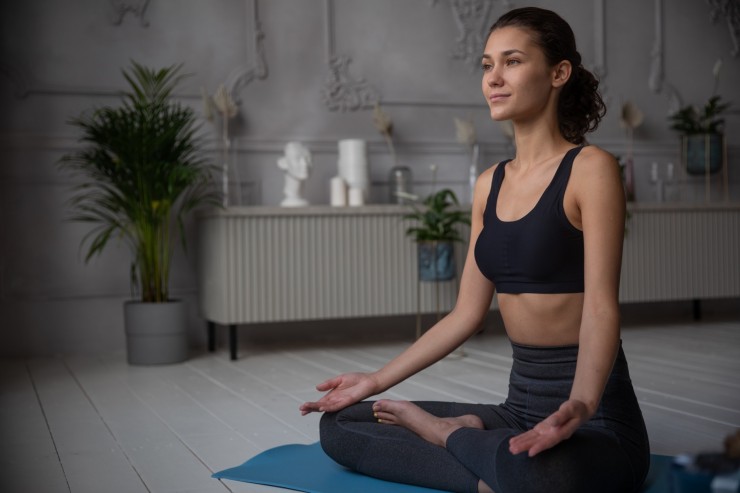In the world of meditation, the traditional image that comes to mind is someone sitting cross-legged with their eyes closed, focusing inward. However, there’s another approach that has been gaining attention: meditating with your eyes open. This practice, known as open-eye meditation, offers unique benefits and can be just as effective as its more traditional counterpart. In this article, we will explore what open-eye meditation is, its origins, techniques, and how it can enhance your meditation practice.
The Concept of Meditating with Eyes Open
Meditation is often associated with closing our eyes and turning our attention inward. However, open-eye meditation challenges this notion by keeping our gaze soft and focused on a specific point or object. This technique allows us to stay present and aware while maintaining a relaxed state of mind. By keeping our eyes open, we remain anchored in the present moment and minimize the potential for distraction. Since our eyes are naturally inclined to move and follow visual stimuli, this practice can help train our focus and attention muscles, enhancing our overall meditation experience.
Origins and Traditions
Open-eye meditation has deep roots in various spiritual traditions. One of the most notable origins can be traced back to Zen Buddhism, where meditating with open eyes is considered an essential part of the experience. It helps practitioners stay grounded in the present moment while becoming more aware of their surroundings and the connection between their inner and outer worlds. Another tradition that utilizes open-eye meditation is Tibetan Buddhism, where practitioners look downward with eyes at a 45-degree angle to limit distractions and create a greater sense of clarity and focus.
Advantages of Open Eye Meditation
One of the main benefits of open-eye meditation is improved focus and attention. By keeping our eyes open during meditation, we maintain a sense of connection with the present moment and enhance our concentration. When meditating with closed eyes, our minds might get lost in thoughts or daydreams, but keeping our eyes open, we remain anchored in the present, focusing more easily on the task at hand. Increased awareness of our surroundings is another advantage of open-eye meditation. With our eyes open, we become more conscious of our environment, developing a heightened sense of self-awareness. This can lead to a better understanding of ourselves and the world around us, ultimately fostering happiness, well-being, and empathy.
Techniques for Meditating with Eyes Open
There are several techniques for meditating with eyes open. One popular method is Zen meditation, which encourages the practitioner to maintain a soft gaze while sitting in a comfortable position. This can be done either on a cushion or a chair, ensuring that the spine is straight. Half-open eyes can reduce wandering thoughts and avoid falling asleep during longer meditation sessions. To practice an open-eye meditation, you can focus on a specific object, such as a tree, flower, or candle flame. Gazing at the object with a soft focus allows you to observe it without becoming overly attached to it. By combining this visual concentration with mindfulness, we can pay attention to our breath and how it moves in and out of our body.
Contrasting Open and Closed Eye Meditation
When it comes to meditation, there are two primary approaches: closed-eye meditation and open-eye meditation. Both methods have their unique advantages and cater to different meditation styles and situations. Closed-eye meditation is perhaps the most common form of meditation for beginners. By closing our eyes, we limit external distractions, making it easier to focus on our breath or a specific object of meditation. This technique helps us cultivate a sense of inner calm, allowing for deeper relaxation and introspection. On the other hand, open-eye meditation has its advantages and can be practiced as our meditation skills advance. One primary benefit is that it allows us to integrate meditation into our daily lives more seamlessly, as it can be performed in busy environments or public places.
Challenges in Open Eye Meditation
Open-eye meditation might seem counterintuitive to some, as we often associate meditation with closed eyes and turning inward. However, it does bring its own unique challenges and benefits. One of the most apparent challenges is dealing with potential distractions. When our eyes are open, we are more exposed to stimuli from our surroundings. For instance, someone walking by, a sudden change in lighting, or even a small insect can easily draw our attention away from our meditation. It requires practice and patience to acknowledge these distractions without getting caught up in them.
Incorporating Other Senses
While practicing open-eye meditation, it’s important to be conscious of our other senses and use them to enhance the experience. By incorporating other senses such as hearing, touch, and an increased awareness of our body, we can deepen our meditation practice even further. As we maintain a soft gaze on an object or our surroundings, let’s also tune into the sounds that surround us. It could be the distant hum of traffic, the chirping of birds, or even the subtle sound of our own breath. By gently acknowledging these sounds without getting attached to them, we can develop a heightened sense of awareness and presence in the moment.
Open Eye Meditation Exercises
In this section, we will discuss several open-eye meditation exercises that can help improve focus, awareness, and a sense of presence. These techniques can be integrated into your regular meditation practice to help you make progress towards your personal goals. One popular open-eye meditation technique is moving meditation. In this exercise, we maintain awareness of our surroundings while engaging in a physical activity, such as walking or yoga. By combining movement with meditation, we can develop greater mindfulness and improve our connection to the present moment.
Stress Management and Relaxation
In today’s fast-paced world, stress has become an inevitable part of our lives. It is essential for us to learn how to manage stress and find ways to relax. One effective approach to achieve this balance is through open-eye meditation. Practicing open-eye meditation helps us enhance our self-awareness, generate a connection with ourselves, and regulate stress. While meditating with eyes closed allows us to deeply focus within, open-eye meditation enables us to stay aware of our surroundings as we meditate. This can be especially useful for those who find closed-eye meditation challenging due to excessive thoughts or discomfort.
Preventing Falling Asleep During Meditation
In some cases, individuals might experience sleepiness or even fall asleep during meditation. To circumvent this issue, we can employ several techniques to maintain alertness throughout our meditation practice. One approach is to meditate with our eyes open or half-open, as this allows us to remain more aware of our surroundings. By gently gazing downward, we send a signal to our brain and body that it is not time to sleep, keeping ourselves more alert and focused on the task at hand.
Exploring Relationship with Environment

In open-eye meditation, we can deepen our relationship with the environment around us. By incorporating elements such as presence, interconnectedness, and observation, we can enhance our awareness of our surroundings while maintaining a meditative state. As we meditate with our eyes open, we can practice being fully present in the moment. Gently gazing at an object or simply allowing our eyes to rest wherever they feel comfortable, we can anchor our attention to the present moment. This aids us in developing a deeper appreciation for the beauty and intricacy of the world around us.
Conclusion
Meditating with your eyes open is a valid and effective way to enrich your meditation practice. By keeping our gaze soft and focused on a specific point or object, we can achieve mindfulness, maintain our focus, and experience the many benefits of meditation. Whether you’re a beginner or an experienced practitioner, open-eye meditation offers a unique opportunity to cultivate mindfulness and concentration. Give this technique a try and see how it can enhance your meditation journey.
Meta Title: Can You Meditate With Your Eyes Open?
Meta Description: Discover the benefits of open-eye meditation and how it can enhance your mindfulness practice. Learn techniques and insights to improve focus and presence.
Author: [Nama Lengkap]
Title/Role: [Jabatan atau keahlian]
Credentials: [Ringkasan kualifikasi atau pengalaman terkait]
Profile Link: [Link profil, opsional]
Sources:
1. [Source 1]
2. [Source 2]
3. [Source 3]
Internal Links:
1. [Link 1]
2. [Link 2]
3. [Link 3]
Featured Snippet Optimization:
Yes, you can meditate with your eyes open. Open-eye meditation involves maintaining a soft gaze and focusing on a specific object or point in your environment. This practice helps improve focus, awareness, and presence, making it a valuable addition to your meditation routine.
Call to Action:
Stay updated with the latest news and insights on meditation practices. Explore today’s headlines and discover new ways to enhance your mindfulness journey.
URL Slug: can-you-meditate-with-your-eyes-open
Image Optimization:



Schema Markup:
{
"@context": "https://schema.org",
"@type": "Article",
"headline": "Can You Meditate With Your Eyes Open? A Complete Guide to Open-Eye Meditation",
"datePublished": "2023-10-05",
"dateModified": "2023-10-05",
"author": {
"@type": "Person",
"name": "[Nama Lengkap]"
},
"publisher": {
"@type": "Organization",
"name": "[Nama Situs]",
"logo": {
"@type": "ImageObject",
"url": "[Logo URL]"
}
},
"description": "Discover the benefits of open-eye meditation and how it can enhance your mindfulness practice. Learn techniques and insights to improve focus and presence.",
"image": [
"https://example.com/image1.jpg",
"https://example.com/image2.jpg",
"https://example.com/image3.jpg",
"https://example.com/image4.jpg",
"https://example.com/image5.jpg"
]
}











More Stories
What Is Yodo Para Tiroides and How Does It Affect Thyroid Health?
How to Claim Your Joy in League of Legends: A Step-by-Step Guide
What is WSET? A Comprehensive Guide to Wine Education